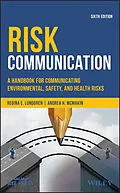THE ESSENTIAL HANDBOOK FOR EFFECTIVELY COMMUNICATING ENVIRONMENTAL, SAFETY, AND HEALTH RISKS, FULLY REVISED AND UPDATED
Now in its sixth edition, Risk Communication has proven to be a valuable resource for people who are tasked with the responsibility of understanding how to apply the most current approaches to care, consensus, and crisis communication. The sixth edition updates the text with fresh and illustrative examples, lessons learned, and recent research as well as provides advice and guidelines for communicating risk information in the United States and other countries.
The authors help readers understand the basic theories and practices of risk communication and explain how to plan an effective strategy and put it into action. The book also contains information on evaluating risk communication efforts and explores how to communicate risk during and after an emergency. Risk Communication brings together in one resource proven scientific research with practical, hands-on guidance from practitioners with over 30 years of experience in the field. This important guide:
* Provides new examples of communication plans in government and industry, use of social media, dealing with "fake news," and new digital tools for stakeholder involvement and crisis communications
* Contains a new chapter on partnerships which covers topics such as assigning roles and expectations, ending partnerships, and more
* Presents real-world case studies with key lessons all risk communicators can apply.
Written for engineers, scientists, professors and students, land use planners, public health practitioners, communication specialists, consultants, and regulators, the revised sixth edition of Risk Communication is the must-have guide for those who communicate risks.
Autorentext
REGINA E. LUNDGREN is an independent consultant in risk communication, public involvement, and science and strategic communication. For more than 30 years, she has specialized in communicating environmental, safety, and health risks to lay audiences. You can learn more at her website at http://www.rlriskcom.com.
ANDREA H. MCMAKIN is a communication specialist at the U.S. Department of Energy's Pacific Northwest National Laboratory in Richland, Washington. For more than 30 years, she has directed, taught, advised on, and carried out the communication of scientific, technical, and risk-related information.
Inhalt
List of Figures XVII
List of Tables XIX
Preface XXI
About the Authors XXIII
1 INTRODUCTION 1
To Begin 2
The Risk Communication Process 6
Audiences, Situations, and Purposes 8
References 8
PART I UNDERSTANDING RISK COMMUNICATION
2 APPROACHES TO COMMUNICATING RISK 11
Cross-Cutting Risk Communication Approaches 12
Care Communication Approaches 20
Consensus Communication Approach 23
Crisis Communication Approaches 24
Summary 26
References 26
Additional Resources 28
3 LAWS THAT MANDATE RISK COMMUNICATION 29
Comprehensive Environmental Response, Compensation, and Liability Act 30
Emergency Planning and Community Right-to-Know Act 31
Executive Order 12898, Environmental Justice in Minority Populations and Low-Income Populations 34
Executive Order 13045, Reduce Environmental Health and Safety Risks to Children 34
Food and Drug Administration Regulations on Prescription Drug Communication 35
National Environmental Policy Act 35
Natural Resource Damage Assessment 36
Occupational Safety and Health Act 37
Resource Conservation and Recovery Act 39
Risk Management Plan Rule 39
Privacy Rule 39
Other Government Inducements 40
Summary 42
References 42
Additional Resources 43
4 CONSTRAINTS TO EFFECTIVE RISK COMMUNICATION 45
Constraints on the Communicator 45
Constraints from the Audience 55
Constraints for Both Communicator and Audience 63
Summary 65
References 65
Additional Resources 67
5 ETHICAL ISSUES 69
Social Ethics 70
Organizational Ethics 77
Personal Ethics 82
Summary 85
References 85
Additional Resources 86
6 PRINCIPLES OF RISK COMMUNICATION 89
Principles of Process 90
Principles of Presentation 95
Principles for Comparing Risks 100
Summary 104
References 104
Additional Resources 105
PART II PLANNING THE RISK COMMUNICATION EFFORT
7 DETERMINE PURPOSE AND OBJECTIVES 109
Factors That Influence Purpose and Objectives 110
Reference 114
Additional Resources 115
8 ANALYZE YOUR AUDIENCE 117
Begin with Purpose and Objectives 118
Choose a Level of Analysis 119
Determine Key Audience Characteristics 122
Determine How to Find Audience Analysis Information 125
Incorporate Audience Analysis Information into Risk Communication Efforts 129
References 132
Additional Resources 133
9 DEVELOP YOUR MESSAGE 135
Common Pitfalls 136
Information People Want 139
Mental Models 141
Message Mapping and Message Development Templates 144
Health Risk Communication 144
Crisis Communication 147
References 150
Additional Resource 151
10 DETERMINE THE APPROPRIATE METHODS 153
Information Materials 153
Visual Representation of Risk 155
Face-to-Face Communication 156
The News Media 158
Stakeholder Participation 160
Technology-Assisted Communication 162
Social Media 163
Partnerships 164
Additional Resources 166
11 SET A SCHEDULE 167
Legal Requirements 167
Organizational Requirements 168
The Scientific Process 169
Ongoing Activities 169
Audience Needs 170
Reference 172
12 DEVELOP A COMMUNICATION PLAN 173
What to Include in a Communic...
